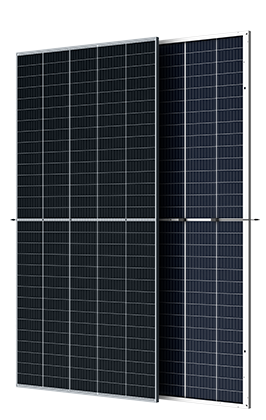Trina Solar, the global leader in integrated PV modules and smart energy solutions, has launched a new range of solar panels in Australia that delivers more than 500W of power from the front surface, significantly more power than previous modules available in this country.
The new modules come replete with several innovative design features and technologies, allowing high power output of more than 500W and module efficiency up to 21%. Trina Solar says these ‘game changing’ products further consolidates its leadership position and heralds a new era of PV modules that bring additional value to the Australian solar market.
The panels deliver more power because each panel incorporates 210mm diameter silicon cells. The larger cell size enables higher area of active light capture, resulting in higher current output. The 150 cells in each panel consist of high efficiency monocrystalline PERC cells and includes a combination of leading solar technologies optimised to boost the panel’s efficiency up to 21%, a higher power output.
These design features include multi-busbar technology which diminishes internal resistance losses within the PV module to a minimum, resulting in better low-light performance. In addition, a highly engineered PV technology is incorporated in the product design that makes it possible to reduce the gap between each cell, therefore, enabling higher overall module efficiency which facilitates balance of system (BOS) cost savings.
Trina Solar's research and development team has also introduced an innovative design that integrates advanced three-cut cell technology using a non-destructive cutting and high-density packaging technology. This further reduces the resistance loss and significantly improves the PV module resistance to cell-cracks and hot spot performance while maximizing space utilization. By doing so, the scientists created high-power modules characterized by high efficiency and high reliability, giving customers security for its performance over a warrantied period of time.
Trina Solar senior country sales manager, Govind Kant, says: “We are already receiving enquiries and accepting orders from customers. Customers can order the Duomax V and Tallmax V modules now and deliveries to Australia will start in this year’s third quarter. We expect to reach 5GW of global manufacturing capacity for the new modules towards end of 2020.”
The first two modules, in the new range that Trina Solar is launching in Australia, are: the Duomax V bifacial double-glass and the Tallmax V modules.
Tallmax V module delivers up to 505W power and up to 21.1% module efficiency, while the Duomax V bifacial module delivers up to 505W front-side power and up to 21% module efficiency.
Duomax V is a bifacial module so it can, therefore, also collect solar energy at the backside of the modules which means additional power gain for end customers. Trina is a leading pioneer in manufacturing glass/glass structure PV modules bringing decades of manufacturing experience into the new 500W bifacial product.

(Photo: Duomax V DEG18MC.20)
The reason Trina Solar decided to first promote the bifacial module is to address the growing market demand from Australia’s utility-scale, commercial and industrial market segments. Trina Solar believes that the new product will pave a way to a more energy yield focused competition in Australian market.
Kant says: “The price gap between bifacial and mono-facial is at a level that the energy yield benefits and BOS savings exceeds the cost premium. Bifacial modules become a preferred choice for customers, because even if you are only getting a few additional percentage-point gains in efficiency from the rear surface, you are still ahead in terms of dollar per kilowatt hours you will get from your system.”
He says bifacial modules are achieving strong traction in the market with customers in the commercial and industrial (C&I) segment, because customers in this segment are big users of electricity, but often have limited roof-space or land for solar installations. This means they need high efficiency, high power modules to maximize the amount of power from the space available.
The benefit of having higher power modules is it significantly reduces balance of system (BOS) costs. Because a fewer number of modules are required, to deliver the total amount of power required from the installation, then: fewer mounting systems and junction boxes are required and less cabling, land and man hours are needed for the project.
Trina Solar used the 500W-plus Duomax V bifacial modules for a large-scale ground-mounted solar farm in northeast China’s Heilongjiang province. The results were a BOS reduction of 6-8% and levelized cost of electricity (LCOE) decrease of 3-4% as compared to conventional 410W bifacial double-glass modules.
“These results are significant and in Australia the BOS savings could be greater because labour costs in Australia are higher than in China. So any reduction in labour costs in Australia could have a significant positive impact on the project’s financial bottom line,” says Kant.
He says he expects Trina Solar’s new 500W-plus modules to be most popular with those that are doing utility-scale projects or large commercial and industrial (C&I) solar installations that are 1MW or more.
